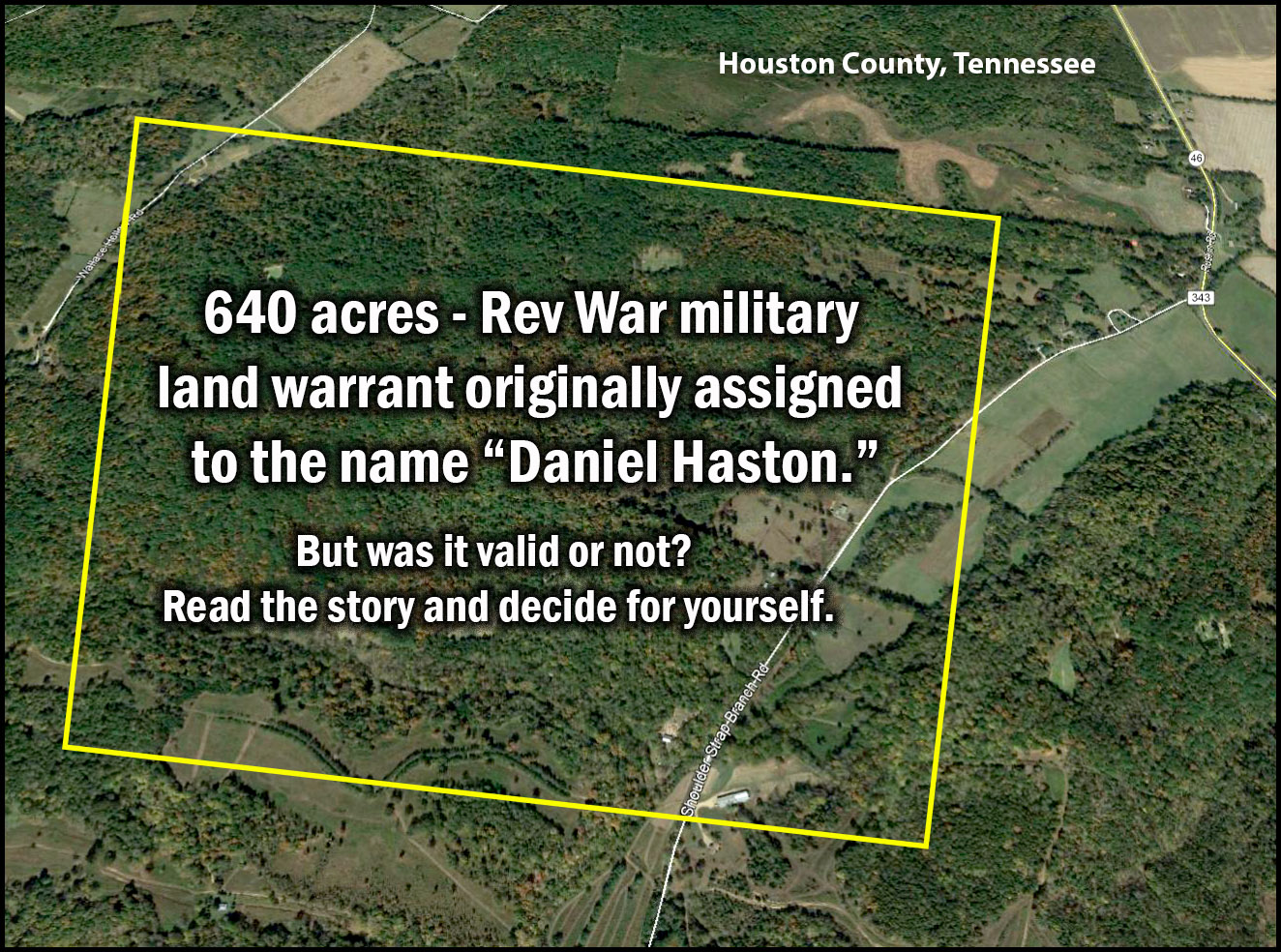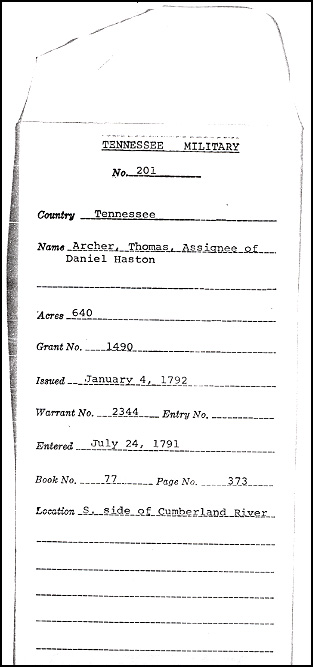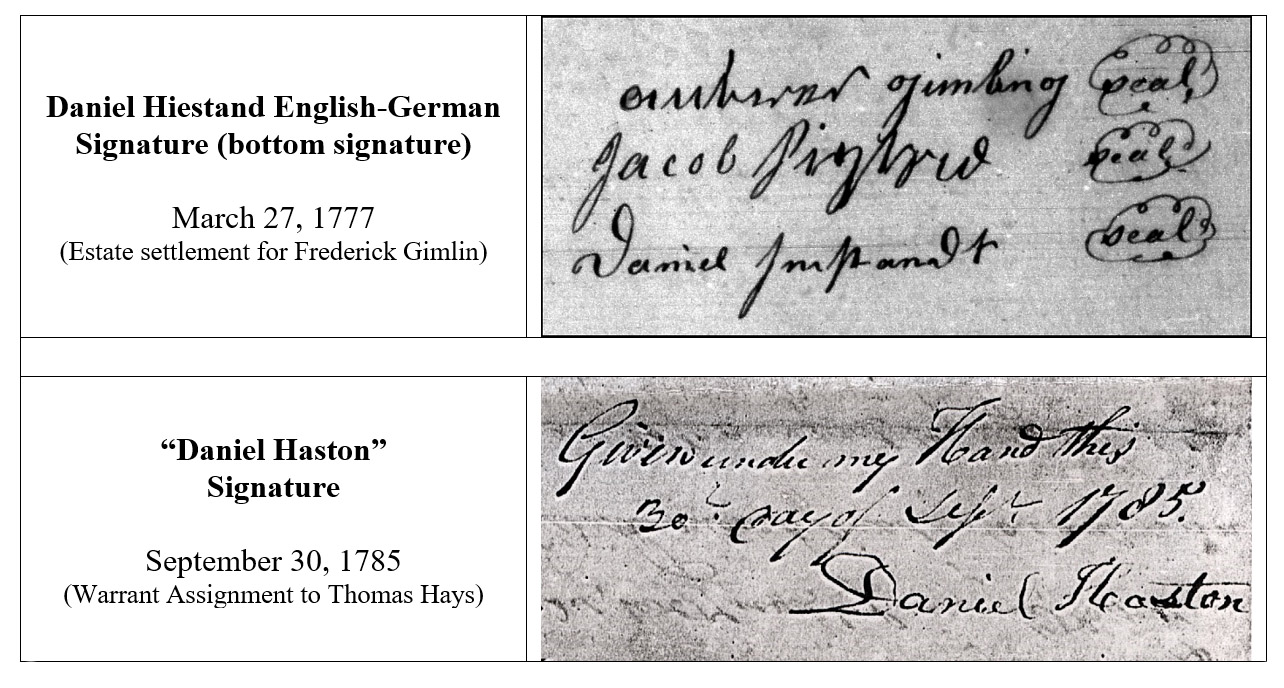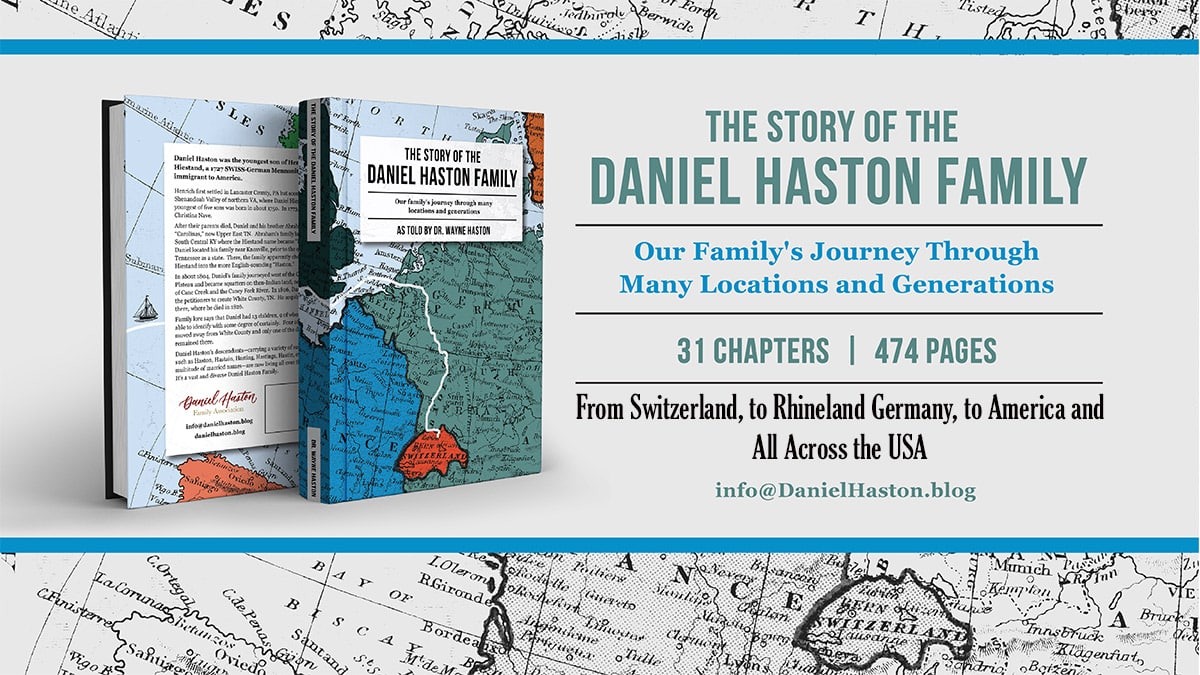The "Daniel Haston" Rev War Land Grant
Legal or Fraudulent?

640 acres in Houston County, TN (west of Nashville) were granted to Thomas Archer, based on Revolutionary War Land Grant #2344. The right to the land was originally issued to a "Daniel Haston." But was the name Daniel Haston just used by NC Secretary of State James Glasgow and his corrupt cronies to sell military bounty land for their own profit? It was discovered that this was a common modus operandi they used in their thieving get-rich scheme that became the focus of the Glasgow Land Fraud Case.
When I began to research the history of the Daniel Haston family in 1999, family tradition was generally committed, and tenaciously so, to the idea that Daniel Haston was a Revolutionary War veteran. However, unlike many family stories about early ancestors, this belief was not based solely on family lore passed down orally through several generations from some unknown original source. It was grounded largely in two documents that on the surface appear to clearly validate the family legend of Daniel’s service in a North Carolina Revolutionary War regiment.
If this topic was being tried in a courtroom, no doubt the first article of evidence would be a survey warrant issued to “Daniel Haston” on September 29, 1785 for a North Carolina military bounty land grant.[i] To gain access to this document is a simple matter of making a request to the State Archives in Raleigh, North Carolina. But there is much more to this document, and the survey that accompanies it in the file, than meets the eye. To understand the full story behind the warrant and survey, and its implications for those of us who claim Daniel Haston as our ancestor, requires some serious additional research as you will see below.
[i] “Thomas Archer, No. 2344, Secretary of State Land Grant Warrant and Survey, S.108.388; Tennessee County, TN.” (Raleigh, NC: North Carolina State Archives).
North Carolina’s Military Bounty Land Grants
In 1780, the North Carolina Assembly passed an act to boost enlistment in the Continental Line of its Revolutionary War army by promising land grants within the state as payment and reward (“bounty”) for military service. That initiative was refined in 1782 and 1783. Here’s the essence of the 1783 law:[i]
[i] A.B. Pruitt, Tennessee Land Entries Military Bounty Land Martin Armstrong’s Office, Part 1, Location book (#3138-4839). (n.p.: printed by the author, 1996), iv-vii.
This law allowed a soldier to receive a “warrant of survey” from North Carolina’s Secretary of State. The survey warrant was a document that permitted a Revolutionary War veteran to locate land and have it surveyed in order to receive a land grant from the state of North Carolina. The amount of land to be surveyed and granted was based on the soldier’s rank and length of service in the North Carolina Continental Army (not including militia duty). Privates who served in the army for seven years (the length of the war) were promised grants of 640 acres; higher ranks were allotted more land. The Secretary of State and his deputies were responsible to verify that the applicants were qualified—had actually mustered and served the required length of time in the North Carolina Army during the Revolutionary War, without deserting.
Problem: James Glasgow, NC Secretary of State and his deputies turned out to be corrupt. The fraud was uncovered after a few years and the result was the Glasgow Land Grant Fraud Case that embarrassed and angered officials in the State of North Carolina.
If a soldier desired, he could endorse the back of the survey in order to sell and assign his rights to anyone, with only a single witness. There was no law that required the Secretary to review the warrant or the survey before the grant was issued and the Land Office in Nashville was not required to review the exchange of rights. Because many of the soldiers “were very poor, ignorant, and credulous, and easily imposed upon by land speculators,”[i] a lot of greedy men took advantage of them, their families, and the state of North Carolina.
[i] Albert Lincoln Bramlett, “North Carolina’s Western Lands.” (PhD dissertation, North Carolina University, 1928), 114.
Because of the absence of reviews and oversight in key steps in the process, the integrity of the entire system was largely dependent on the first step in Secretary Glasgow’s office, verifying if applicants were qualified to receive a warrant of survey. Officials in the North Carolina government later came to regret their failure to build more accountability into this process. Fifteen years after North Carolina legislators enacted the law, they rued their neglect to supervise the system more carefully.
Problem: James Glasgow, NC Secretary of State and his deputies turned out to be corrupt.
Military Bounty Land Warrant #2344 and Grant #1490
A “warrant” was a certificate that permitted the recipient to locate and survey land. A “grant” was the final document that actually transferred the land to the grantee.

At the State Archives of North Carolina in Raleigh, there are a couple of military bounty land documents (a warrant for a survey and the survey itself) filed under the name of “Thomas Archer, Assignee of Daniel Haston.” On September 29, 1785, a man named “Daniel Haston,” or someone using that name, received a private’s warrant of survey for 640 acres as compensation for Revolutionary War service. The documents are filed in the name of Thomas Archer because Archer was the man who eventually owned the rights to the warrant, located the land, requested the survey, received the grant, and settled on the granted tract.
The original recipient of the warrant (whoever that was) almost immediately transferred the warrant to Thomas Hays (probably “Thomas Hays” of Guilford County, North Carolina). Hays was assigned the rights to the warrant on September 30, 1785, the day after the warrant was issued under the authority of the North Carolina Secretary of State’s office.
This transfer of a warrant was not at all unusual. Many of the recipients of warrants for North Carolina military land grants sold them because the difficulty of occupying these granted lands was incredibly challenging at that time. Thomas Hays later sold the warrant to Thomas Archer of Guilford County, North Carolina, on November 7, 1785.
The "Daniel Haston" Warrant #2344 in the Fraud Investigation
On September 29, 1785, 37 (thirty-seven!) warrants for military bounty land surveys were delivered to William Faircloth by the Deputy Secretary of State, Willoughby Williams.[i] This means that Faircloth, who had been a lieutenant in the 10th Regiment of the North Carolina Continental Army, was supposedly representing and vouching for 37 Revolutionary War warrantees in order to receive their warrants and deliver them to the rightful owners. But more than half (19 of the 37) of these military land warrants were “mentioned” in the Glasgow Land Fraud case, meaning there were indications of fraudulent activity related to these 19 warrants. With almost all of these fraudulent warrants, the Commissioners noted that the “soldier didn’t muster” (or deserted) and the “warrant assignment forged.”
[i] Pruitt, Tennessee Land Entries, Part 3, 538-543.
On the same day, Faircloth also presented 14 non-military survey warrants from the James Armstrong office for men who were purported to have been soldiers and all 14 of those were suspected to be fraudulent. So, 65% (33 of 51) warrants delivered to William Faircloth on that one day were suspected to be illegal.
The #2344 “Daniel Haston” military warrant was one of the warrants noted as “not mentioned in Glasgow land fraud.”
Sept. 29, 1785 warrant 2344 Pvt. Daniel Haston 640 ac delivered to Wm Faircloth, 84 months; file #36; grant to Thos Archer; [for grant see file #201 in Tennessee Co; MARS 12.14.19.200 warrant not mentioned in Glasgow land fraud].[i] [Italics and bold type added by this author.]
[i] Pruitt, Tennessee Land Entries, Part 3, 542.
While this is certainly not bad news, it is not necessarily good news for those of us who would like to think that our ancestor was a Revolutionary War soldier. Remember that the Commissioners did not have time to deeply investigate all 5,000+ warrants. To this point, Dr. Pruitt stated:
It is highly probable that in some instances the Commissioners may have considered and reported against some warrants as fraudulent, which in fact were fair, and against some persons as concerned in the fabrication of illegitimate assignment, who in truth were not concerned; it is certain also that they have passed over many warrants as fair, which were not fair, and left unnoticed and unimpeached many persons who had been employed in cheating the soldier and the State. These errors have not crept in from inattention, but from their not possessing the means to description or detection in some ample manner as was necessary for the discharge of so difficult a duty.[i]
[i] Pruitt, Glasgow Land Fraud Papers, Part 1 & Index, 52.
So, for the “Daniel Haston” warrant to have not been mentioned in the fraud case, does not prove that the warrant was legitimate and that a man by that name had served in the North Carolina army during the war.
When I first saw the “warrant not mentioned in Glasgow land fraud” comment, with regard to the “Daniel Haston” warrant, I was greatly relieved, thinking, “That settles it; Daniel Haston truly was a Revolutionary War veteran.” But deeper investigation into the warrant and the circumstances behind it have raised several questions and concerns in my mind about the validity of the warrant.
Questions and Concerns
1. How could our Daniel Haston have served in the war for seven years and his name not appear on any muster list or pay roll list?
There is now no known-to-me (or known to Dr. A.B. Pruitt and Russell Koonts who searched all of the known available records) muster list or pay roll or pay voucher that mentions Daniel Haston’s name as a soldier in the Revolutionary War. His name as a Revolutionary War soldier only appears with reference to this one document
2. How could he have served for seven years in a North Carolina regiment, with what we know about his residence and family in the Northern Neck of Virginia during at least part of that time, as was presented in the previous chapter?
Where Daniel lived in Virginia to the northern border of North Carolina is approximately 200 miles, three and a half hours of travel by car today, but probably a week on horseback in Daniel’s time. That’s just to the northern border of North Carolina. And what about the fact that at least two children (probably three) were born to Daniel Haston in the very midst of the war, David on May 6, 1777 and Joseph on January 9, 1780? Another child appeared in the family census record prior to 1783, when the war ended.
3. How can we trust any warrant assigned to William Faircloth?
William Faircloth, from Dobbs County, North Carolina, was an officer (briefly) in the inglorious Tenth Regiment of the North Carolina Army, but only for 131 days (January 20, 1778 through June 1, 1778).[i] He certainly was not a significant officer in the unit. Led by Colonel Abraham Sheppard (father-in-law of James Glasgow), the Tenth Regiment was “more of a hindrance than any great aid to the war effort.”[ii] “Colonel Sheppard and the officers under his command “disobeyed orders on frivolous and insufficient reasons.”[iii] Colonel Sheppard’s paymaster, Benjamin Sheppard, and quartermaster, Alexander Outlaw, were declared unworthy of holding their offices because of suspicion of counterfeiting.[v]
[i] Gertrude Sloan Hay, Roster of Soldiers from North Carolina in the American Revolution. (Baltimore, MD: Genealogical Publishing, 1984), 22, 123.
[ii] Hugh F. Rankin, The North Carolina Continentals. (Chapel Hill, NC: The University of North Carolina Press, 1971), 138.
[iii] Rankin, 134.
[iv] Rankin, 130.
[v] Rankin, 133.
“After the close of the war, some of the colonels of the regiments failed to return muster rolls and records. The law provided, however, that the soldiers be granted lands on certificates from the colonels of their regiments, certifying that they had served at least two years.” William Faircloth was never a colonel, only a Lieutenant and he was only in the army from January 20, 1778 through June 1, 1778. How could he have vouched for Daniel Haston as serving in the war for at least two years?[i]
[i] Bramlett, 96.
Ten years prior to the discovery of fraud in the distribution of military bounty land, William Faircloth was indicted for defrauding the state by falsely procuring pay from the accounts of soldiers.[i] A special court was established in January 1787 at Warrenton, North Carolina to try Faircloth and several others accused of pay fraud. Many of these same men would later be found to have been involved using similar methods of fraud in the Glasgow Land Fraud case.
[i] Russell Scott Koonts, “The Warrenton Army Frauds” (unpublished document, 1997), 11.
If 65% of the survey warrants presented to William Faircloth on September 29, 1785—same place, same day, by the same man—were illegally issued or reassigned, there is a definite cause for concern that the “Daniel Haston” warrant (as well as some others “not mentioned”) might also have been wrongfully issued. One of the “mentioned in the Glasgow land fraud” warrants (warrant #2349) issued on that day was assigned to Thomas Hays, the same man who acquired the rights to the “Daniel Haston” #2344 warrant and later sold it to Thomas Archer. Guess who purchased the rights to warrant #2349? Thomas Archer!
September 29, 1785 warrant 2349 [no names] heirs of Pvt. Richard Rose 640 ac delivered to Wm Faircloth; 84 months; file and grant [blank]*; [warrant in Tennessee Revolutionary War warrants (roll 4), assigned Apr. 30, 1785 by Sampson Rose (or Rece), to Martin Armstrong (John Smith witness) and assigned Nov. 7, 1785 by Thomas Hays to Thomas Archer (Robert McKennie and James Hays witness); grant #1957 from state of Tennessee included, entry #1259 dated Jan. 5, 1808, grant to John Davidson for 340 ac in Stewart Co on Trace Cr of Tennessee R; warrant mentioned in part 3 p. 61 of Glasgow land fraud; soldier didn’t muster; warrant taken to Tennessee in 1801 by William Christmas.[i]
[i] Pruitt, Tennessee Land Entries, Part 3, 542-534.
So, William Faircloth did not assume the post-war task of distributing warrants with the credibility of a highly efficient and trustworthy officer who had an outstanding record of military service. And September 29, 1785 was just one day in the post-Revolution life of William Faircloth; he was involved with numerous other ‘bad” warrants at other times.
Lt. William Faircloth was never brought to trial for his participation in the land fraud cases. Why? Because he had died in prison, for his central role in ripping off soldiers in pay fraud. Nearly all of the pay accounts that Faircloth had been involved in were found to be fraudulent. He had withdrawn £6,935.8.11 (pounds, shillings, pence) from the treasury.[i] Sixty-five percent of the “soldiers” for whom pay had been drawn by the total group of pay fraud perpetrators were for men whose names never appeared on any muster roll. So, forgery of names was common. Less than 5% of the accounts were deemed to be good and accurate.[ii] The name of “Daniel Haston” was not mentioned in any way in the Warrenton Pay Fraud investigations.
[i] Koonts, “The Warrenton Army Frauds,” 18.
[ii] Koonts, “The Warrenton Army Frauds,” 29-30.
4. How does the “Daniel Haston” assignment signature (to Thomas Hays) compare with a known-to-be-genuine signature of Daniel Hiestand/Haston?

The "Much More" That Could Be Said
Summarizing an entire chapter (Chapter 10 in my in-progress book) of 50+ pages into one blog article requires that I have to be selective in what I include. And in the case of this article, the story continues through the first 12 or so pages of Chapter 11.
Chapter 11 provides background on some of the main characters in the story: Thomas Hays, his brother James Hays, Robert McKemie (brother-in-law of James Hays), and Thomas Archer. All four of these men were from Guilford County, NC–think Greensboro, NC.
For years, earlier Haston researchers assumed that “Fairfield,” where the assignment of Warrant #2344 and subsequent transfer happened was a little place in Hyde County, NC very near the Atlantic Coast. But actually “Fairfield” was the plantation of Secretary of State, James Glasgow, in then-Dobbs County, NC. When you do some detective work concerning (1) the distance between Guilford County and old-Dobbs County and (2) some of the dates related to the issue and transfer of Warrant #2344, some serious questions arise about the legitimacy of this “Daniel Haston” Warrant #2344.
I’ve added a “bonus” article that address some of the Chapter 10 and Chapter 11 content which I referred to in the previous paragraphs.
If you appreciated this article, please share it with others who might also enjoy it.

